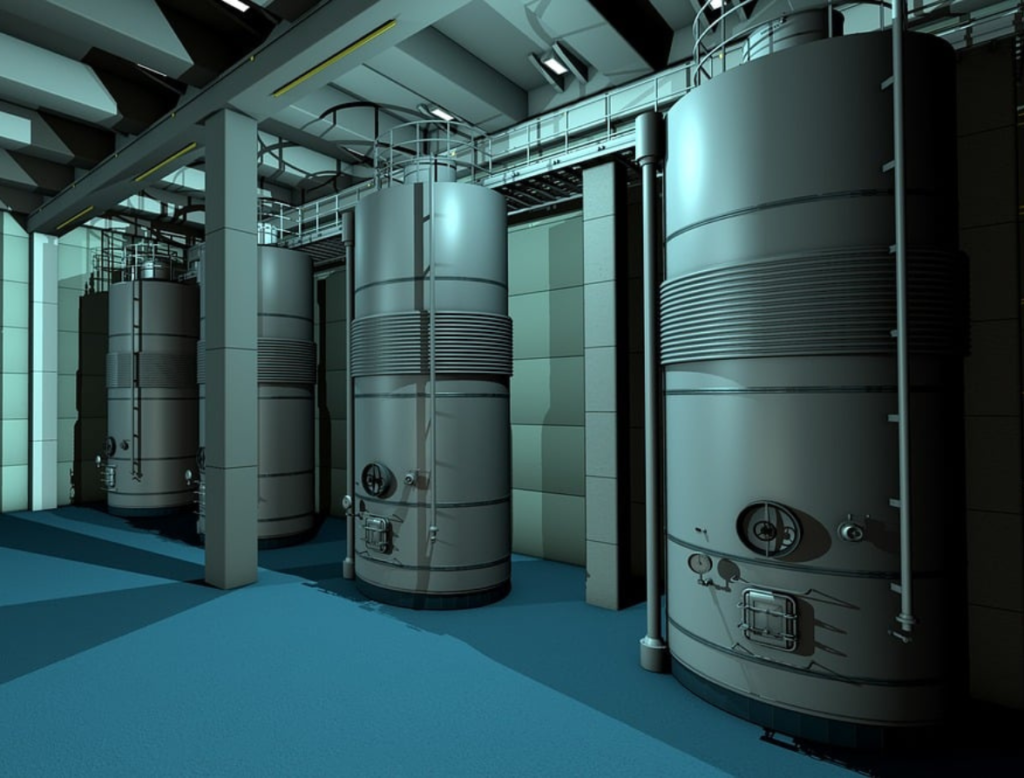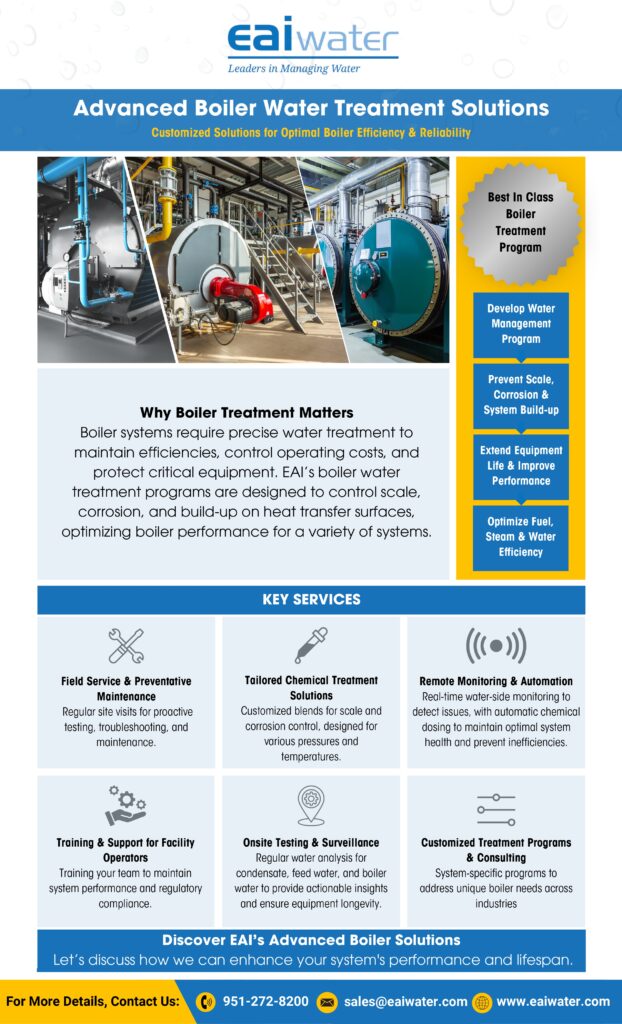Best Practices for Monitoring and Testing Boiler Water Quality
Boiler systems are critical to industrial operations, from energy generation to manufacturing processes. However, poor water quality management can lead to severe issues such as corrosion, scaling, carryover, and efficiency loss. These challenges not only increase operational costs but also risk equipment damage and downtime, affecting overall productivity.
Effective boiler water testing ensures the early detection and resolution of water quality issues. Regular monitoring of key parameters, such as pH, conductivity, dissolved oxygen, and alkalinity, helps facilities maintain system efficiency, reduce chemical usage, and comply with industry standards. Techniques like phenolphthalein alkalinity tests and phosphate testing are particularly effective for assessing water chemistry and ensuring proper chemical treatment.
At EAI Water, we combine over 35 years of expertise with advanced monitoring solutions to help facilities prevent water quality failures. Our approach includes low-dose chemical treatments, real-time monitoring tools, and operator training programs, ensuring both efficiency and safety.

Key Parameters for Monitoring Boiler Water Quality
Maintaining boiler efficiency and longevity begins with regular testing of critical water quality parameters. Each parameter provides insight into potential issues like scaling, corrosion, and carryover, enabling operators to take corrective action before problems escalate.
1. pH Levels
- Proper pH levels (typically 8.5–10.5 for most boiler systems) are crucial to prevent both corrosive and scaling conditions.
- Testing Methods: Use a pH meter or colorimetric pH test kits for accurate measurements.
- Actionable Tip: Regularly adjust pH with neutralizing amines or pH balancers to maintain system stability.
2. Conductivity
- Measures the concentration of dissolved solids in boiler water and indicates when blowdown is necessary.
- Ideal Range: Varies by boiler type and pressure but typically ranges between 3,000–10,000 µS/cm for low- and medium-pressure systems.
- Testing Tools: Conductivity meters or handheld testers provide precise data to optimize cycles of concentration.
3. Total Dissolved Solids (TDS)
- High TDS levels can cause foaming and carryover, leading to contamination of steam and reduced system efficiency.
- Testing Methods: TDS meters or evaporation techniques to measure solids concentration.
- Optimization Tip: Balance TDS levels through controlled blowdown and pretreatment systems like reverse osmosis.
4. Oxygen Levels
- Dissolved oxygen is a primary driver of corrosion in boiler systems.
- Testing Procedures: Use a dissolved oxygen meter or titration kits.
- Prevention: Apply oxygen scavengers, such as sodium sulfite or hydrazine, to neutralize oxygen and protect metal components.
5. Alkalinity
- Alkalinity stabilizes pH levels and prevents caustic embrittlement, protecting boiler tubes from stress cracking.
- Key Tests: Perform phenolphthalein alkalinity and methyl orange alkalinity tests to monitor total alkalinity levels.
- Target Range: Maintain alkalinity between 300–700 ppm, depending on system specifications.
6. Phosphate Levels
- Phosphates help prevent scaling by controlling calcium and magnesium hardness in the boiler water.
- Testing Procedure: Use a phosphate test kit to monitor levels and adjust dosing accordingly.
- Ideal Range: Typically maintained between 20–50 ppm for low- and medium-pressure systems.
7. Silica Content
- Excessive silica can cause hard, glass-like deposits in boiler tubes and steam turbines, reducing efficiency.
- Testing Methods: Use silica test kits or photometric analyzers.
- Control Strategy: Adjust blowdown rates and incorporate pretreatment systems to manage silica levels effectively.
Best Practices for Boiler Water Monitoring and Testing
Maintaining optimal boiler water quality requires more than regular testing—it demands the implementation of proactive strategies and modern technologies to ensure efficiency and safety. Below are actionable best practices for effective boiler water monitoring and treatment.
1. Automate Blowdown Control
- Why It Matters: Manual blowdown often results in inconsistencies, leading to either excessive water and energy loss or insufficient removal of impurities, which can cause scaling.
- Solution: Install automated blowdown controllers to precisely regulate the process based on real-time conductivity readings.
- Benefits:
- Reduces water and fuel waste.
- Minimizes operator intervention.
- Ensures consistent removal of dissolved solids, preventing scale buildup.
2. Implement Advanced Pretreatment Systems
- Challenge: Untreated feedwater introduces impurities that cause scaling and corrosion.
- Solution: Incorporate pretreatment systems such as reverse osmosis (RO), dealkalizers, or softeners to reduce hardness, alkalinity, and dissolved solids.
- Benefits:
- Allows boilers to operate at higher cycles of concentration, reducing blowdown frequency.
- Improves the effectiveness of chemical treatments by reducing competing reactions.
3. Optimize Condensate Return
- Why It Matters: Condensate is a valuable resource, as it contains both heat and pure water with minimal contaminants.
- Solution: Improve condensate recovery rates by repairing leaks, maintaining steam traps, and monitoring return lines for efficiency.
- Benefits:
- Reduces fuel consumption by retaining heat energy.
- Lowers the demand for chemical treatments due to the high purity of recovered condensate.
4. Maximize Chemical Treatment Efficiency
- Key Considerations:
- Over-dosing wastes chemicals and increases operational costs.
- Under-dosing risks corrosion, scaling, and equipment failure.
- Solution:
- Conduct routine water quality tests (pH, TDS, and alkalinity) to adjust dosages.
- Use low-dose formulations, including oxygen scavengers, phosphates, and dispersants, to target specific challenges.
- Tip: Reassess chemical formulations regularly, especially if feedwater sources or environmental conditions change.
5. Leverage Digital Monitoring Technologies
- Why It Matters: Modern boiler systems benefit from real-time data, enabling operators to identify and resolve issues quickly.
- Solution:
- Install sensors to continuously monitor parameters like conductivity, oxygen levels, and temperature.
- Use automated dosing systems to ensure precise chemical application.
- Benefits:
- Reduces downtime with instant alerts for anomalies.
- Improves accuracy and consistency in water treatment.
6. Train Operators and Conduct Regular Audits
- Why It Matters: Even the best equipment requires skilled operators to interpret data and execute corrective actions.
- Solution:
- Provide hands-on training for facility staff, focusing on water quality testing, interpreting results, and implementing treatment adjustments.
- Schedule regular audits to evaluate system performance and identify areas for improvement.
- Benefits:
- Enhances operational efficiency and reduces the risk of human error.
- Ensures regulatory compliance and long-term system reliability.
Common Boiler Water Issues and Troubleshooting Tips
Even with regular testing and proactive maintenance, boiler systems can encounter common water quality challenges. Understanding these issues and implementing effective troubleshooting techniques can help facilities avoid costly downtime and ensure safe operations.
1. High Conductivity and TDS Levels
- Problem: Elevated conductivity and total dissolved solids (TDS) levels lead to scale formation, foaming, and carryover, reducing system efficiency.
- Troubleshooting Tips:
- Increase blowdown frequency to control dissolved solids.
- Verify conductivity meter calibration for accurate monitoring.
- Evaluate feedwater quality and pretreatment efficiency (e.g., softeners or reverse osmosis).
2. Corrosion in Boiler Tubes
- Problem: Corrosion occurs due to oxygen infiltration, low pH, or the formation of acidic compounds such as carbonic acid.
- Troubleshooting Tips:
- Add oxygen scavengers, such as sodium sulfite, to neutralize dissolved oxygen.
- Increase pH using neutralizing amines or alkalinity balancers.
- Inspect deaerator tanks to ensure they are operating at optimal temperature and pressure for oxygen removal.
3. Scaling and Deposits
- Problem: Hardness minerals like calcium and magnesium precipitate, forming insulating deposits on heat transfer surfaces.
- Troubleshooting Tips:
- Monitor hardness levels and add scale inhibitors (e.g., phosphates or polymers).
- Adjust cycles of concentration based on conductivity readings to maintain proper blowdown rates.
- Ensure pretreatment systems, such as water softeners, are functioning correctly.
4. Foaming and Carryover
- Problem: Foaming leads to water droplets being carried with steam, contaminating downstream equipment.
- Troubleshooting Tips:
- Maintain proper TDS levels through blowdown.
- Use anti-foam agents to suppress foam formation.
- Verify boiler water alkalinity and adjust as needed.
5. Inconsistent Chemical Dosing
- Problem: Overdosing wastes chemicals and increases operational costs, while under-dosing can lead to scaling, corrosion, or microbial growth.
- Troubleshooting Tips:
- Use automated dosing systems for precision application.
- Conduct regular water quality tests (e.g., pH, phosphate, and TDS) to fine-tune dosages.
- Reassess chemical formulations if feedwater characteristics change.
6. Silica-Related Scaling
- Problem: High silica levels result in hard deposits that reduce efficiency, particularly in high-pressure systems.
- Troubleshooting Tips:
- Monitor silica levels using dedicated test kits or analyzers.
- Implement reverse osmosis or other pretreatment systems to reduce silica concentration.
- Adjust blowdown rates to manage silica buildup effectively.
Practical Troubleshooting Framework
- Identify Root Cause: Use monitoring tools to pinpoint which parameter is out of range (e.g., high conductivity, low pH).
- Take Immediate Action: Apply corrective measures such as adjusting blowdown, adding chemicals, or recalibrating sensors.
- Prevent Future Recurrence: Review monitoring data, optimize pretreatment, and schedule regular audits to ensure long-term stability.
How can EAI support your Boiler Treatment needs?

At EAI Water, we provide comprehensive solutions designed to address the unique challenges of boiler water treatment. Our approach combines advanced equipment, custom-formulated chemicals, and expert support to ensure peak system performance, safety, and sustainability.
Custom-Formulated Chemicals
Our low-dose boiler water treatment chemicals are engineered to deliver maximum efficiency while minimizing environmental impact. These include:
- Oxygen Scavengers: Remove dissolved oxygen to prevent corrosion, with a focus on safe, cost-effective options like sodium sulfite.
- Phosphates and Polymers: Prevent scale buildup and control particulate accumulation for clean heat transfer surfaces.
- Neutralizing Amines: Elevate pH levels to protect systems from acidic corrosion (alternative solutions like dealkalizers can reduce amine usage).
- Anti-Foam and Dispersants: Prevent carryover and loosen surface deposits to improve chemical circulation.
Remote Monitoring and Automation
EAI’s remote monitoring systems take the guesswork out of boiler water management by providing real-time insights into water quality and operational performance. Features include:
- Automated chemical dosing based on conductivity, temperature, and system runtime.
- Alerts for anomalies like pressure changes, leaks, or dosing issues.
- Reduced downtime through quick responses to potential problems.
Operator Training and Facility Support
Our commitment doesn’t end with the technology. EAI’s experts work alongside your team to:
- Deliver hands-on operator training for interpreting metrics and optimizing performance.
- Conduct regular audits and service visits to maintain system reliability.
- Provide actionable recommendations through detailed water analysis reports.
Take Action to Optimize Your Boiler Water Quality
Proactively monitoring and managing boiler water quality is key to ensuring safe, efficient, and reliable system operations. With over 35 years of expertise, EAI Water offers tailored solutions that combine advanced technologies, custom-formulated chemicals, and expert support to address your facility’s unique needs. From preventing scaling and corrosion to optimizing chemical dosing and improving energy efficiency, our programs are designed to protect your equipment and reduce operational costs.
Ready to optimize your boiler system? Learn more about our solutions or contact us to schedule a free onsite consultation with our experts.
FAQs
Q: How often should boiler water quality be tested?
A: For optimal performance, water quality should be tested daily or multiple times a day in high-demand systems. Conductivity, pH, and oxygen levels are key metrics to track regularly.
Q: What are the benefits of remote monitoring systems?
A: Remote systems provide real-time data, automate chemical dosing, and alert operators to potential issues before they escalate, reducing downtime and ensuring system reliability.
Q: How can I reduce chemical use in my boiler system?
A: Implementing strategies like optimizing deaerator tanks, increasing condensate recovery, and using low-dose chemical formulations can significantly reduce chemical use and costs.
Q: What is the role of pretreatment in boiler water management?
A: Pretreatment removes impurities like hardness and alkalinity from feedwater, preventing scaling, reducing blowdown frequency, and improving system efficiency.
Q: Why is operator training important for boiler management?
A: Even the best equipment requires skilled operators to interpret data, manage treatments, and address system-specific challenges. EAI provides comprehensive training to empower your team.